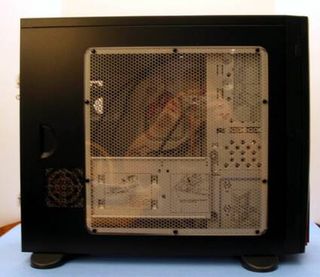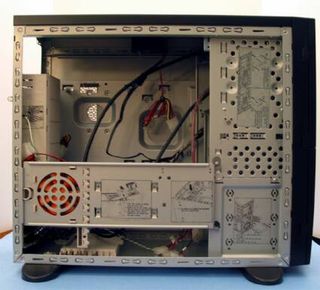2003 Winter Case Review Part 2: The ATX Avalanche
Thermaltake Xaser III VM3000A: Skull Series, Continued
Once users get beyond the honeycomb EMI protected window, there is still much to like about the VM-3000A. The VM-3000A includes many new design ideas and concepts that Thermaltake has incorporated into their latest case offering. Some of these items may meet with a lukewarm response, but the majority of these new features will be greeted with much interest. First, the VM-3000A offers an entirely screwless design that is truly screwless - everything, from attaching the motherboard to the motherboard tray and beyond - does not require any tools. We put Thermaltake to the challenge on this claim and we were able to install all of the components without using any tools. We did, however, require a screwdriver to remove the side panel fan assembly in order to gain better access to install the motherboard. Beyond that, no tools were required.

A look at the honeycomb windowed side panel.
As with most Thermaltake products, the VM-3000A is of high quality construction. The combination of SECC steel and aluminum serve this case well. The chassis exhibited nearly no twist and very little bend due to its solid construction. It would appear that Thermaltake has gone to great lengths to make certain that this gamer/enthusiast case is absolutely the strongest it can be. This is a good thing, as we expect we will see a number of these VM-3000As being toted to and from LAN parties.

A look at the inside of the VM-3000A.
The internal construction of the VM-3000A features a series of rolled and folded edges. The quality is good, although in some of the more hidden areas, we found a rough edge here and there that could potentially inflict a scrape or two. Overall, the majority of the case was smooth and clean, which speaks well for Thermaltake's quality. The unique integrated grills on the side panels provide additional ventilation for the VM-3000A. The case relies on this side panel intake fan methodology to draw air into the case and exhaust it out the rear. The case is configured to handle a 92mm fan in the front. While the front bezel has to be removed to install this additional fan, this fan works with the bezel-integrated venting to draw additional air into the case to be exhausted out the rear.
Stay on the Cutting Edge
Join the experts who read Tom's Hardware for the inside track on enthusiast PC tech news — and have for over 25 years. We'll send breaking news and in-depth reviews of CPUs, GPUs, AI, maker hardware and more straight to your inbox.
Current page: Thermaltake Xaser III VM3000A: Skull Series, Continued
Prev Page Thermaltake Xaser III VM3000A: Skull Series Next Page Thermaltake Xaser III VM3000A: Skull Series, ContinuedMost Popular

